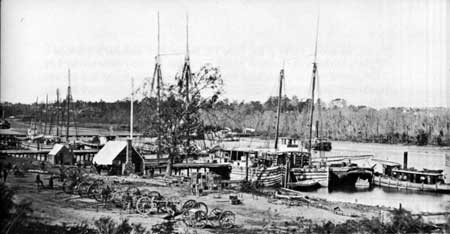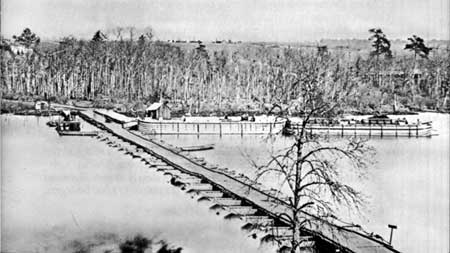|
PETERSBURG National Battlefield |
 |

Broadway Landing on the Appomattox River where the
XVIII Corps of the Army of the James crossed on June 15, 1864. It was
later used as an ordnance depot by the Union Army.
Courtesy,
National Archives.
The Battle of Petersburg, June 15—18,
1864
After the Battle of Cold Harbor on June 3, Grant had abandoned, for a time at least, his plan to capture Richmond by direct assault. With characteristic zeal he had ordered Meade to move the Army of the Potomac across the James River and to invest the more southerly city. On June 14 Grant and Butler conferred at Bermuda Hundred. At that time orders were given for the attack on Petersburg.
The first of the Northern forces to arrive on the scene of battle was the XVIII Corps of the Army of the James. Early in the morning of June 15 these troops, commanded by Gen. William F. Smith, crossed from Bermuda Hundred to the south side of the Appomattox by means of a pontoon bridge at Broadway Landing. Eighteen thousand Union soldiers were on their way to face less than 4,000 under Beauregard. Throughout the day they approached the city and assembled for the attack.
The Union offensive opened shortly after 7 p. m. on June 15. Among the first places to fall was Battery 5, one of the strongest of the Confederate positions. Entering the ravine between Batteries 7 and 8 Smith's men were able to approach Battery 5 and take it from the rear, the direction from which an attack was least expected. Within a few hours Beauregard had lost not only Battery 5 but all the line for more than a mile south. The defenders withdrew and threw up a hasty entrenchment along Harrison's Creek, well to the rear of the captured section of the line. While this Confederate retreat was taking place, the Union II Corps, commanded by Gen. Winfield S. Hancock, arrived to reinforce the attacking columns.
The appearance on the field of the II Corps was an ominous sign for the Confederacy. While the initial attacks were taking place on June 15, the Army of the Potomac had been busily engaged in crossing the James River farther to the east, on pontoon bridges. The number of Union troops south of the river was increasing hourly until by midnight of June 16 the entire army, numbering at least 90,000, had crossed.
Darkness ended the fighting on June 15, but early the next day the attacks were renewed. More of the defense line south of the portion captured the previous day now gave way. In response to repeated entreaties from Beauregard throughout June 15 and 16, Lee ordered more divisions to the support of Petersburg. This necessitated the draining of precious reserves from the Richmond lines. By dusk of that second day Beauregard could muster about 14,000 to face the enemy. Thus, the center of attention rapidly shifted from Richmond to Petersburg, which had so recently seemed of but secondary importance.
The third day of battle was practically a repetition of that of the preceding day. Again the Northern forces attacked the Confederate troops, concentrating their efforts to the south of the positions captured earlier. Again the Confederates were forced to draw back. A decisive break through of the opposing line was now anticipated by the assaulting forces. At about 12:30 a. m., June 18, Beauregard ordered his troops to begin a withdrawal to new positions about a mile closer to the city. Throughout the early morning hours of that day Beauregard had his men busily engaged in the construction of this defense line. Colonel Roman, aide to Beauregard, later recalled that "without a moment's rest the digging of the trenches was begun, with such utensils as had been hastily collected at Petersburg, many of the men using their bayonets, their knives, and even their tin cans, to assist in the rapid execution of the work."

Pontoon bridge at Broadway Landing constructed
by the Union Army in 1864.
Courtesy, National Archives.
A general assault was ordered for the Union forces at 4 a. m. on June 18. When the attack began it was soon discovered that the ranks of the enemy had not been broken nor had the city fallen into Northern hands. The eastern section of the Dimmock Line was empty except for a thin line of skirmishers who were gradually forced back. The Northern troops came on, crossing the Norfolk and Petersburg Railroad south of where the defenders had constructed their line. The advance continued until they were brought face to face with the muzzles of the defender's guns. Meanwhile, elements of Lee's command continued pouring in to aid their comrades. Lee, himself, came down from his temporary head quarters near Chester, Va., to direct the defense operations in person.
Throughout that June Saturday, brisk action occurred on the new Petersburg front. The major Union drive, involving elements of four corps, came about 3 p. m. Artillery hammered the Confederates. Charges of infantry were made only to be hurled back. During the course of one of these futile drives the 1st Maine Heavy Artillery, according to William F. Fox (Regimental Losses in the American Civil War), suffered the most severe losses of any regiment in a single engagement of the entire war. About 4 p. m. this unit, 850 strong, charged from the concealment of the Prince George Court House Road north of where Fort Stedman was soon to stand. Met by a heavy crossfire, it withdrew in less than one-half hour, with 632 casualties.
As on the previous days, fighting ended with the coming of darkness. Grant's attempt to capture Petersburg had failed, with a loss of 10,000 men; but his efforts could not be considered entirely unsuccessful. Two of the railroads leading into the city had been cut, and several roads were in Union hands. Behind the Northern troops was City Point which Grant speedily converted into a huge supply base.
The major result of the opening 4 days of combat, however, was the failure of the Federal forces to break the Confederate defense line. First Beauregard, and then Lee, had held against heavy odds. They had been pushed back closer to their base but they had held. Possibly if Smith had advanced his XVIII Corps farther into the defenses on the opening night, Petersburg would have fallen on June 15 or 16. But that had not been done, and the campaign was to run nearly 10 more months.
The lines of battle before Petersburg were clearly drawn. Between 47,000 and 51,000 men defended it against 111,000 to 113,000 besiegers. The defenses of Richmond now stretched from White Oak Swamp, east of that city, south to the Jerusalem Plank Road, 26 miles away. The fate of the Army of Northern Virginia—of the Confederate capital itself— would depend upon the outcome of the drive against Petersburg.

|

| History | Links to the Past | National Park Service | Search | Contact |
|
Last Modified: Mon, Dec 2 2002 10:00:00 am PDT |

